剑桥国际英语教程一级 Unit6 How often do you exercise精编版
- 格式:ppt
- 大小:13.85 MB
- 文档页数:33
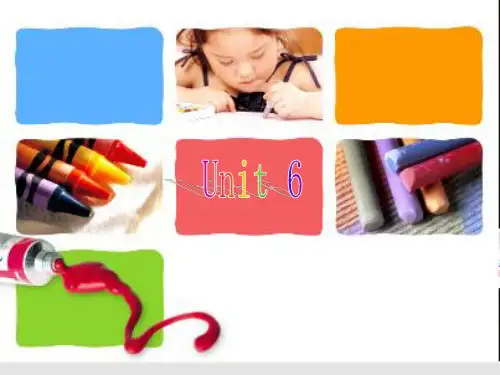
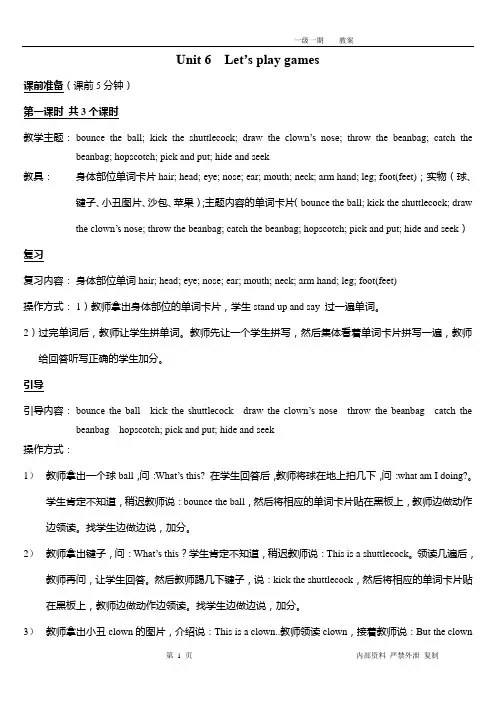
Unit 6 Let’s play games课前准备(课前5分钟)第一课时共3个课时教学主题: bounce the ball; kick the shuttlecock; draw the clown’s nose; throw the beanbag; catch the beanbag; hopscotch; pick and put; hide and seek教具:身体部位单词卡片hair; head; eye; nose; ear; mouth; neck; arm hand; leg; foot(feet);实物(球、键子、小丑图片、沙包、苹果);主题内容的单词卡片(bounce the ball; kick the shuttlecock; drawthe clown’s nose; throw the beanbag; catch the beanbag; hopscotch; pick and put; hide and seek)复习复习内容:身体部位单词hair; head; eye; nose; ear; mouth; neck; arm hand; leg; foot(feet)操作方式: 1)教师拿出身体部位的单词卡片,学生stand up and say 过一遍单词。
2)过完单词后,教师让学生拼单词。
教师先让一个学生拼写,然后集体看着单词卡片拼写一遍,教师给回答听写正确的学生加分。
引导引导内容:bounce the ball kick the shuttlecock draw the clown’s nose throw the beanbag catch the beanbag hopscotch; pick and put; hide and seek操作方式:1)教师拿出一个球ball,问:What’s this? 在学生回答后,教师将球在地上拍几下,问:what am I doing?。
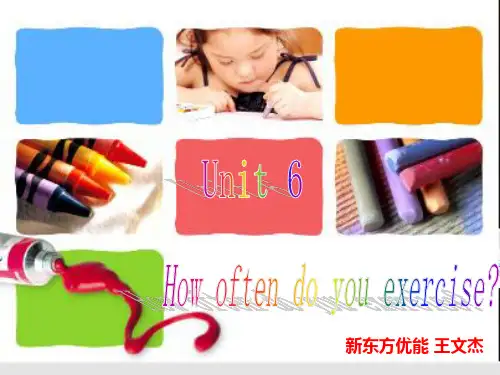
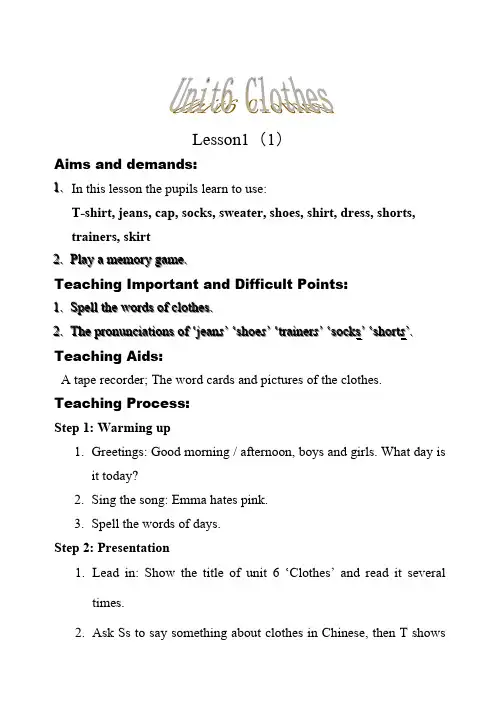
Lesson1 (1) Aims and demands:1.1.In this lesson the pupils learn to use: T-shirt, jeans, cap, socks, sweater, shoes, shirt, dress, shorts, trainers, skirt2.2.Play Play a a memory memory game.game.Teaching Important and Difficult Points:1.1.Spell Spell the the words words of of clothes.clothes.2.2.The The pronunciations pronunciations of of ‘jean ‘jean s s ’’ ‘shoe ‘shoe s s ’’ ‘trainer ‘trainer s s ’’ ‘sock ‘sock s s ’’ ‘short ‘short s s ’.’.Teaching Aids:A tape recorder; The word cards and pictures of the clothes.Teaching Process:Step 1: Warming up 1.Greetings: Good morning / afternoon, boys and girls. What day isit today?2.Sing the song: Emma hates pink.3.Spell the words of days.Step 2: Presentation 1.Lead in: Show the title of unit 6 ‘Clothes’ and read it several times.2.Ask Ss to say something about clothes in Chinese, then T showsthe corresponding pictures.T-shirt, jeans, cap, socks, sweater, shoes, shirt, dress, shorts,trainers, skirt (Spell the words one by one and compare ‘jeans’ ‘shoes’ with ‘ shorts’ ‘socks’.)Step 3: practice1.Listen to the tape, pointing to the words and follow it.2.A game: Mouth the word. (The whole— for each group’scompetition-- single)3.A guessing game: T says a letter, which is the fist letter of oneword. For example ‘s’, SS can guess what word it is.Step 5: ConsolidationStep 6: Homework1.Listen to and read the words 3 times.2.Draw the clothes they like.Lesson2 (2)Aims and demands:1.1.In this lesson the pupils learn to sing the song: My favourite T-shirt.Teaching Important and Difficult Points:1.1.The The phrases phrases and and sentence:sentence: My My favourite favourite ..is ..is ……Teaching Aids:A tape recorder; The pictures and word cards of clothes; Some masks of children; The picture of kite.Teaching Process:Step 1: Warming up / Review.1.Greetings: Good morning / afternoon, boys and girls. What day isit today?2.Sing the song: Emma hates pink.3.Review: From the song above, elicit the sentence ‘Emma hates pink. What’s your favourite colour?’— ‘What’s your favourite toy?’( My favourite toy is a kite. ) -- ‘What’s your favourite clothes?’ (T-shirt, jeans, cap, socks, sweater, shoes, shirt, dress, shorts, trainers, skirt) When Ss say the thing, T shows the picture.Step 2: Presentation1.A game: Helping the children wear the clothes. (Stick the mask on Bb and put on the clothes.)T: I’m … My favourite T-shirt is green. My favourite jeans is blue. My favourite cap is red and yellow. (Read it and Write the sentences on Bb.)2. Ask Ss to the front to choose their favourite clothes. Then putthem on children’s body and practice to say the target sentences.(Little teacher leads, others follow.)Step 3: Practice1. Practice in pairs: Show the clothes they have prepared and tell thepartner what colour is their favourite clothes.2. Show their beautiful pictures of clothes they chose and saysomething about it.4.Open the books to P50, Part 2: Listen twice and sing the song.5.A game: What’s wrong in the picture.Step 5: ConsolidationStep 6: Homework1.Listen to the tape 3 times and sing it.2.Copy the words about clothes 4 times on the books.3.Recite the words: T—shirt, jeans.Lesson 3 (3,4)Aims and demands:1.In this lesson the pupils learn to understand: Turn off the alarmclock. Get out of the bed. Put on your T-shirt. Shout ‘Oh, on!’2.Pupils learn to say the word: cycle helmet.3.Understand instructions and mime the actions.4.Listen and fill in the numbers.Teaching Important and Difficult Points:1.Understand instructions and mime the actions.Teaching Aids:Word cards and pictures of clothes; A tape recorder; A clock; The picture of cycle helmet.Teaching Process:Step 1: Warming up / Review1.Greetings:T: Good morning / afternoon, boys and girls. How are you today?What day is it today?2.Sing the song: My favourite T-shirt. (Two Ss sing in the front.)3.Spell the words: T—shirt, jeans.Step 2: Presentation1.Lead in: A guessing game (By listening to the sound of thealarm clock, SS guess what is in T’s hand— the alarm clock.Then show the clock and read it several times.)2.Situations: Draw a picture on the Bb, and ask SS what they arewhile drawing them. (a bed, a door, a window, a T-shirt, theshorts, the socks, the trainers, a cycle helmet) When show thecycle helmet, teach it several times.Turn off the alarm clock. (T pretends to be sleeping on thebed. When the clock alarms, T turns off it. Say it 3 times.)Get out of bed. ( T shows the action of getting up. )Put on your T–shirt. (Pretend to put on the T-shirt.)Put on your shorts. (Pretend to put on the shorts.)Put on your socks. (Pretend to put on the socks.)Put on your trainers. (Pretend to put on the trainers.)Put on your cycle helmet. (Pretend to put on the helmet.)Open the door. (Pretend to open the door.)Shout: ‘Oh, on.’ (It’s raining outside.Shout.)Step 3: Practice1.Learn it sentence by sentence.2.Listen to the story.3.Listen twice and mime the actions.4.Listen to the mixed order and mime the actions.5.A match among groups, listening to the mixed order and do theactions.6.A match among 5 Ss. (After saying one instruction, Ss they trytheir best to mime the action, if someone is the slowest one or do the wrong action, he or she will be quite. At last, just one S is thefinal winner.)7.Open to the books and listen and point.8.Listen again and number the pictures.Step 3: Homework1.Listen to the tape 3 times and do the actions.2. Recite the words: cap, dress.Lesson 4 (5,6)Aims and demands:1.In this lesson the pupils learn to understand: What’s his / her name?Ann is wearing (a blue skirt).2.Ding a logic puzzle.3.Deciding if written sentences are right or wrong.Teaching Important and Difficult Points:1.Listen to the details and distinguish the different clothes.2.SS can understand the sentences ‘…is wearing…’.Teaching Aids:Word cards and pictures of clothes, recorder;Teaching Process:Step 1: Warming up / Review1.Greetings:T: Good morning / afternoon, boys and girls. How are you today? What day is it today?2. Sing the song; My favourite T-shirt.3. Ask S to spell the words: cap & dress.Step 2: Presentation1.Lead in: Draw 2 stick figures on Bb, one is a boy, the other is a girl,Who are both wearing clothes. Write he and she. According to the stick figures, then do an introductive activities. Describe the clothing of one and ask Ss to guess which one it is.e.g He’s wearing a blue cap, a yellow T-shirt and blue jeans. Who itis.She’s wearing a pink dress, and brown shoes. Who it is.2.Do another descriptions about the clothing of pupils in class andothers gusee who it is. (A few examples.)E.g It’s a boy. He’s wearing blue jeans and black shoes. What’s hisname?It’s a girl. She’s wearing blue jeans and black shoes. What’s her name?(Write the target sentences on Bb. Ask Ss to answer with ‘It’s (Bob)’) Step 3: Practice1.Open the books and read the names of the pupils. (Part 5)2.Listen to the tape and point to the pictures.3.Listen again and write the names in the blanks.4.Check the answers.5.(Part6) Explain the meaning of ‘ right’ and ‘wrong’. And ask SS toread the sentences themselves. Then explain if necessary.6.Do the exercise and check the answer by oral.Step 3: Homework1.Listen to the tape 3 times and point to the pictures.2.Recite the words: socks & sweaterBlackboard design / Note:Lesson 5 (7, 8)Aims and demands:1.In this lesson the pupils learn to understand:Mike is wearing agreen cap, a red T- shirt, green jeans, black socks and brown shoes.2.Read a short descriptive text and colour a picture accordingly.3.Colour a picture and producing a short descriptive text.Teaching Important and Difficult Points:Producing a short descriptive text according to the picture they draw. Teaching Aids:Word cards and pictures of clothes, recorder; three white pitures with a boy on it.Teaching Process:Step 1: Warming up / Review1.Greetings:T: Good morning / afternoon, boys and girls. How are you today? What day is it today?2. Sing the song; My favourite T-shirt.3. Ask S to spell the words: socks & sweater4.Review the sentence pattern: (Mike) is wearing (a green cap).①A game: Ask 5 Ss to stand in a line and T describes the wearing ofS, then says “ 1,2,3”. Others bend their knees quickly. If one reacts slowly or wrongly, he / she will be quit.②A game: Another 5 Ss stand in a line, T describes one pupil, others guess who it is.Step 2: Presentation1.Lead in: Show the pictures of the clothes and ask what it is and whatcolour it is. Then elicit the phrases like ‘a green cap’ ‘blue jeans’…then T shows a boy in white and writes some descriptions about him on Bb, like ‘ Peter is wearing a green cap, ared T-shirt, blue jeans and yellow shoes.’ After reading the sentence above and colour the boy according to the decriptions.2.Ask SS to read the sentence above.3.Open the books and read the text fist and then colour the picture.(Part 7)4.Colour the picture and write the text accordingly. (Part 8)Step 3: Practice1.Try to read the text to the partner, which they wrote by themselves.2.Ask a singe S to read his or her text.Step 3: Homework1.Read the text 3 times.2.Recite the words: shoes & trainersAims and demands:1.In this lesson the pupils learn to the sentence: Run out of the door.2.Read the poem and remember it with the help of a skeleton text. Teaching Important and Difficult Points:Read the poem and remember it with the help of a skeleton text. Teaching Aids:Word cards and pictures of clothes, recorder;Teaching Process:Step 1: Warming up / Review1. Greetings:T: Good morning / afternoon, boys and girls. How are you today? What day is it today?2. Sing the song; My favourite T-shirt.1.Spell the words of the clothes in the mucis.2.Ask S to spell the words: shoes & trainers3.Review: Mime the actions. (P51)Step 2: Presentation1.From the actions, elicit the phrase “ put on…” Write it on Bb andread it for several times. Then replace the word after ‘put on’ and ask Ss to be the little teacher to teach.Step 3: Practice1.T calls S’ name and gives an instruction to him or her ‘ put onyour…’, the student do the corresponding action or uses the picture they have prepared (to a few Ss) and say ‘OK’2.Practice in pairs.3.A game: Ask Ss in one line to make sentences with ‘ put on…’4.Listen to the poem and elicit the new sentence: ‘Run out of thedoor.’5.Listen to the poem again and try to say it according to the picture onBb.6.Say the poem by different roles (boys and girls) .Then exchange.7.Cover the text, just look at the skeleton to say the poem.Step 4: Homework1.Listen to the poem and say it 3 times.3.Recite the words: shirt & skirtLesson 7 (10,11,12)Aims and demands:1.In this lesson the pupils learn to the sentence: What am I wearing?2.Do a word puzzle, draw and colour the clothes.3.Match indefinite articles with singular nouns plus adjectives. Teaching Important and Difficult Points:1.Do a word puzzle, draw and colour the clothes.2.Match indefinite articles with singular nouns plus adjectives. Teaching Aids:Word cards and pictures of clothes, recorder;Teaching Process:Step 1: Warming up / Review1. Greetings:T: Good morning / afternoon, boys and girls. How are you today? What day is it today?2.Say the poem.3.Spell the words of the clothes in the music.4.Ask S to spell the words: shirt & skirtStep 2: Presentation1.Describe all the pictures of clothes. T just teach three, the rest aretaught and learnt by Ss.‘a green T-shirt’ ‘blue jeans’ ‘green shorts’(write the phrases on Bb and read.)2.Pick up all the pictures and mix them, then ask Ss to stick them to thecorrect pictures.3.A guessing game: Ask S to the front to the game with T. They arestanding back to back and guess the colour of the clothes of each other. “ What am I wearing?” “ I think…”When play this game, learn the language. And ask another two Ss to show.Step 3: Practice1.Practice in pairs and show it in class.2.Do the exercise of Part 11: Complete the puzzle. Draw and colour theclothes.3.Do the exercise of Part 12.Step 4: Homework1.Read the contents 3 times.2.Recite the words: shorts。
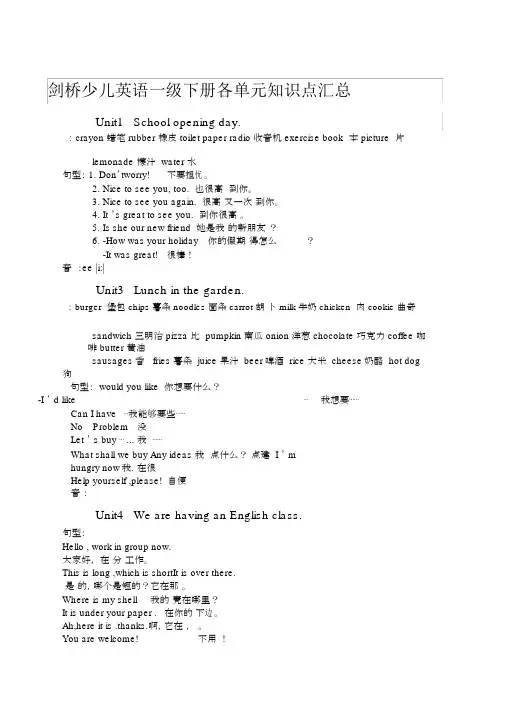
剑桥少儿英语一级下册各单元知识点汇总Unit1School opening day.: crayon 蜡笔 rubber 橡皮 toilet paper radio 收音机 exercise book本 picture 片lemonade檬汁 water 水句型: 1. Don’tworry!不要担忧。
2.Nice to see you, too. 也很高到你。
3.Nice to see you again. 很高又一次到你。
4.It ’s great to see you. 到你很高。
5.Is she our new friend 她是我的新朋友?6. -How was your holiday你的假期得怎么?-It was great!很棒!音:ee |i:|Unit3 Lunch in the garden.: burger 堡包 chips 薯条 noodles 面条 carrot 胡卜 milk 牛奶 chicken 肉 cookie 曲奇sandwich 三明治 pizza 比 pumpkin 南瓜 onion 洋葱 chocolate 巧克力 coffee 咖啡 butter 黄油sausages香 fries 薯条 juice 果汁 beer啤酒 rice 大米 cheese奶酪 hot dog 狗句型: would you like 你想要什么?-I ’ d like⋯我想要⋯⋯Can I have⋯我能够要些⋯⋯No Problem没Let ’ s buy ⋯ ... 我⋯⋯What shall we buy Any ideas 我点什么?点建 I ’ mhungry now我.在很Help yourself ,please! 自便音:Unit4We are having an English class.句型:Hello , work in group now.大家好,在分工作。

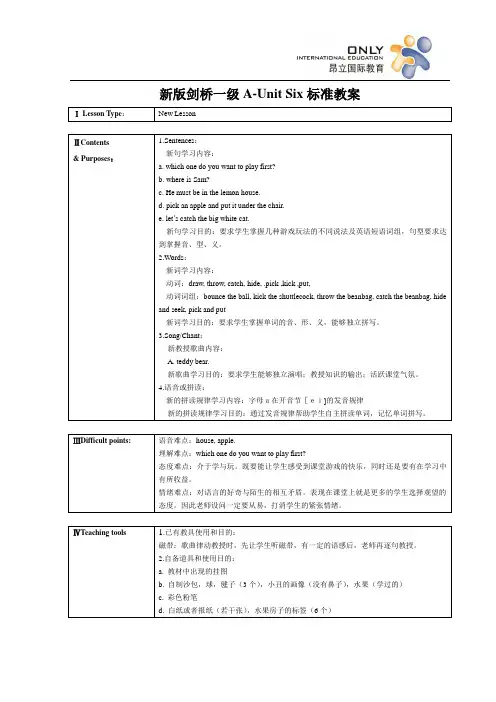
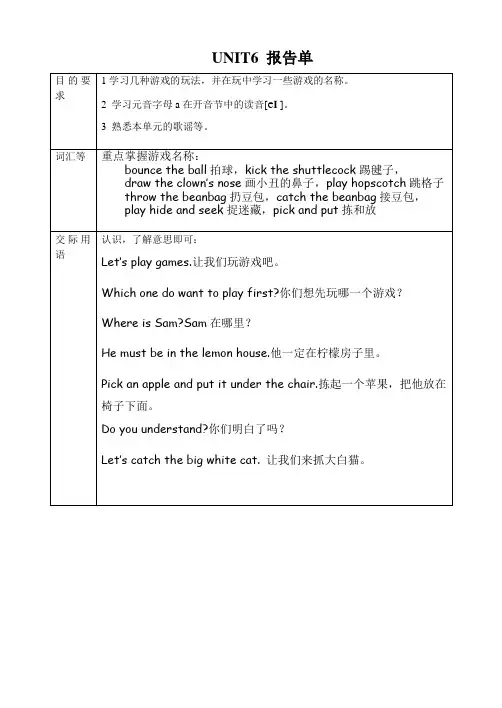
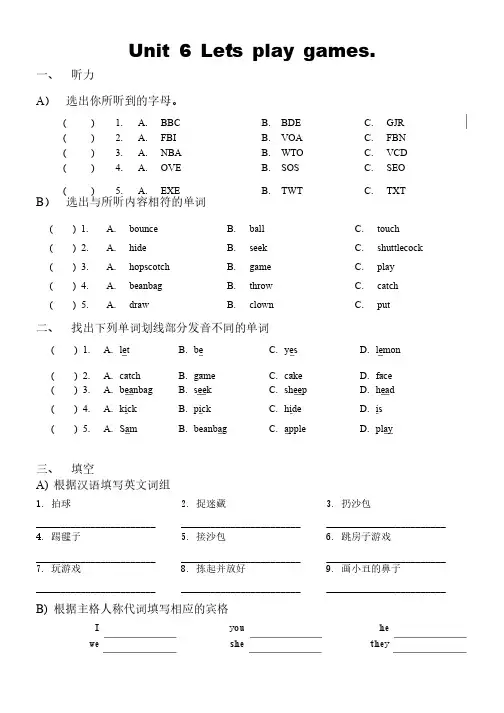
Unit 6 Let ’s play games.一、 听力A ) 选出你所听到的字母。
( ) 1. A. BBC B. BDE C. GJR ( ) 2. A. FBI B. VOA C. FBN ( ) 3. A. NBA B. WTO C. VCD ( ) 4. A. OVE B. SOS C. SEO ( ) 5. A. EXE B. TWT C. TXT B ) 选出与所听内容相符的单词二、 找出下列单词划线部分发音不同的单词( ) 1. ( ) 2. ( ) 3. ( ) 4. ( ) 5. A. A. A. A. A. let catch beanbag kick Sam B. B. B. B. B. be game seek pick beanbag C. C. C. C. C. yes cake sheep hide apple D. D. D. D. D. lemon face head is play 三、 填空A) 根据汉语填写英文词组1. 1. 拍球拍球拍球2. 2. 捉迷藏捉迷藏捉迷藏3. 3. 扔沙包扔沙包扔沙包________________________ ________________________________________________4. 4. 踢毽子踢毽子踢毽子5. 5. 接沙包接沙包接沙包6. 6. 跳房子游戏跳房子游戏跳房子游戏 ________________________ ________________________ ________________________7. 7. 玩游戏玩游戏玩游戏8. 8. 拣起并放好拣起并放好拣起并放好9. 9. 画小丑的鼻子画小丑的鼻子画小丑的鼻子 ________________________________________________________________________B) 根据主格人称代词填写相应的宾格I you he weshethey( ) 1. A. bounce B. ball C. touch ( ) 2. A. hide B. seek C. shuttlecock ( ) 3. A. hopscotch B. game C. play ( ) 4. A. beanbag B. throw C. catch ( ) 5. A. draw B. clown C. put C) 在需要的地方填写be 动词1. 3. 5. 7. 9. How many balls ______ do you have? Which game ____ do you want to play? What ______ that? It ______ a giraffe. They ______ our friends. 2. 4. 6. 8. 10. We ______ would like some grapes. Let Let’’s ______ draw the clown’s nose. Do _____ you understand? Yes, I do ______. ______ that a crocodile? D) 填写名词的适当形式 I I have have have got got got a a a small small small ______ ______ , , two two two ____________ ,two ,two ______________, , a a a big big ________and black ______ . 四、 选择题( ) 1. Let ____ play games. A. I B. me C. my ( ) 2. Where is Sam? A. A house. B. It is a house. C. In the house. ( ) 3. Which game do you want to play? A. Pear. B. Bounce the ball. C. Clown. ( ) 4. Where _____ Tom and Sam? A. is B. are C. do ( ) 5. What can you bounce? A. The ball. B. The hand. C. The feet. ( ) 6. What can you kick? A. Clap. B. Shuttlecock. C. Hopscotch. ( ) 7. I can draw the clown ’s nose. A. is B. has C. 的 ( ) 8. Let Let’’s catch the beanbag. A. us B. is C. has ( ) 9. clown A. B. C. ( ) 10. shuttlecock A. B. C. 五、 翻译1、Pick an apple and put it under the chair. ___________________________________________________________________ 2、Do you understand? ___________________________________________________________________ 3. He must be in the lemon house. ___________________________________________________________________ 4. Let ’s catch the big white cat. ___________________________________________________________________ 。
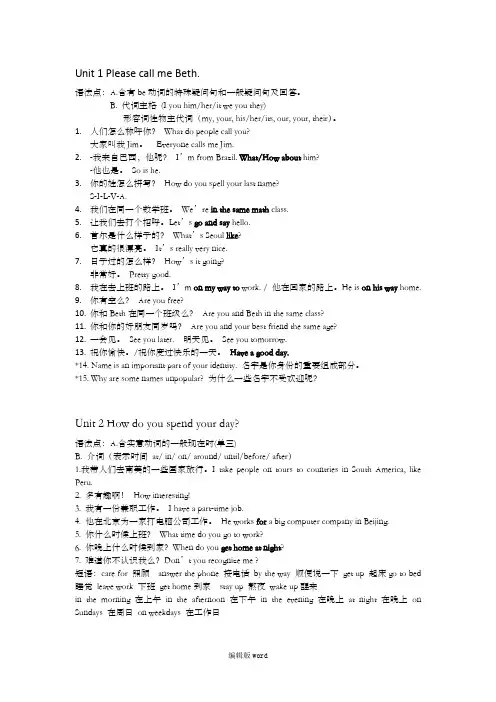
Unit 1 Please call me Beth.语法点:A.含有be动词的特殊疑问句和一般疑问句及回答。
B. 代词主格(I you him/her/it we you they)形容词性物主代词(my, your, his/her/its, our, your, their)。
1.人们怎么称呼你?What do people call you?大家叫我Jim。
Everyone calls me Jim.2.-我来自巴西,他呢?I’m from Brazil. What/How about him?-他也是。
So is he.3.你的姓怎么拼写?How do you spell your last name?S-I-L-V-A.4.我们在同一个数学班。
We’re in the same math class.5.让我们去打个招呼。
Let’s go and say hello.6.首尔是什么样子的?What’s Seoul like?它真的很漂亮。
It’s really very nice.7.日子过的怎么样?How’s it going?非常好。
Pretty good.8.我在去上班的路上。
I’m on my way to work. / 他在回家的路上。
He is on his way home.9.你有空么?Are you free?10.你和Beth在同一个班级么?Are you and Beth in the same class?11.你和你的好朋友同岁吗?Are you and your best friend the same age?12.一会见。
See you later. 明天见。
See you tomorrow.13.祝你愉快。
/祝你度过快乐的一天。
Have a good day.*14. Name is an important part of your identity. 名字是你身份的重要组成部分。
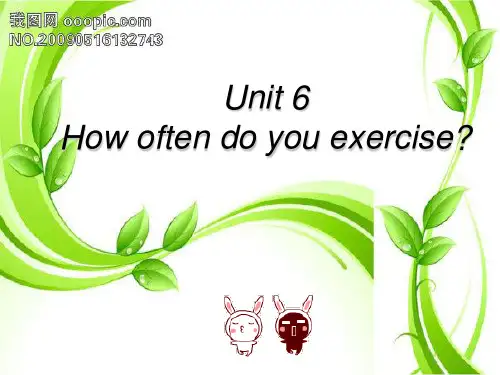
Unit 6 More fun at “Word Factory”.教学目的和要求Teaching aims and demands 本单元将继续加强学生的拼音及词汇学习,使学生今后能较容易地拼写单词进一步巩固元音字母的开、闭音节的读音及辨认继续学习字母组合or 的读音使学生能比较熟练地拼写一些有规律的单词交际用语Expressions in communication How happy I am!I’ve got a name.Which is my name?Just a minute.It’s ready.We sound the same.Can we be friends?This way, please.Meet your new friend.重点朗读词汇Key words and expressions same, boat, bike, car, monkey, bad, desk, family, game,way, please, wait, sound, factory, fun, meet所需教具Materials for teaching 元音字母a, e,,I, o, u 卡片用于练习音素的卡片字母组合or 读音卡片单元教学活动1 Look and play.教师进入教室跟学生打招呼后说:“Hello, boys and girls. Today we are going to have more fun with the words. We are going to a word factory. Please open your books and turn to Page 31, I’m going to say something about the word factory.” 教师开始给学生讲造词工厂的故事。
“Look, this is a machine. They are making words. Two children are putting the letters inside this machine, and then it makes many words. This animal is very happy because he’s got a name. His name is bee.” 教师指着飞机说:“And he’s asking about his name. ‘Hi! Which is my name?’ And this little bird is answering, ‘Just a minute. It’s ready.” 突然,教师有些惊讶并指着箱子里的单词说:“Oh, look here. Lots of bad names. Do you know bad names? They are not correct. He throws th e bad names into this box. People here are very busy.” 教师分别指这些工作人员说:“He is sorting the words out. He says, ‘same family word. This way, please.’ You see,” 教师指着最上面的人说:“When the words are put together, it becomes a book. This person carries many books and ho lds a group of words which make up a sentence. Do you know what it is? ‘This is my favourite word game!’ Finally, the books are ready. Many children are waiting to get their books.” 讲完之后,教师接着说:“Now let’s first meet some friends here.” 教师拿出元音字母a 闭音节的读音卡片:bat, had, pan, sat, add, cad, jam, pat, tag, cap, ant, cat, man, ran, dad, map, bag, bad, hat, sad, nap, flag, 让大家一一地认读。
课题:unit 6 how often do you exercise?课时:6课时日期:第11周,星期四教材分析一、教学内容本课时是教材《剑桥国际英语教程学生用书1》(外语教学与教研出版社)二、教学重点和难点1. 重点:How to talk about something2. 难点:Vocabulary, sentence structure三、教学目标1. 知识目标⑴ Help the students to learn how to talk about exercise⑵ asking about and describing routines and exercise; talking about frequency; discussing sports and athletes; talking about abilities.2. 能力目标1. adverbs of frequency: always, almost always, usually, often, sometimes, hardly ever, almost never, and never; questions: how often, how long, how well, and how good; short answers.3. 情感目标充分利用生动直观的教学手段,借助动作和练习帮助学生熟练掌握课文内容四、教学方法和工具:情景教学、寓教于乐、多媒体课件六、板书设计(设计意图:用不同颜色的粉笔让学生对本节课所学的新词、要求掌握的重点一目了然。
同时,教师的板书也是学生很好的笔记样板。
学生在记笔记的过程中也学会了该如何突出重点。
)。
骐骥教育剑桥英语一级作业单第六单元More fun at "Word Factory"Ⅰ、默写单词:(要求:会读,会英汉互译,会默写)请家长朋友将孩子不会的单词圈出来factory工厂fun乐趣boat船bike自行车car汽车monkey钱desk桌子family家game 游戏way路please请wait等(待)sound声音meet见面Ⅱ、重点句型(要求:熟读,能做到英汉互译)请家长朋友将孩子不会的句子圈出来1. How happy I am! 我好高兴啊!2. I’ve got a name. 我有名字了。
3. Which is my name?那个是我的名字?4. Just a minute.稍等。
5. It’s ready.准备好了。
6. We sound the same.我们的发音是一样的。
7. Can we be friends?我们能做朋友吗?8. This way, please.请这边走。
9 Meet your new friend.见见你的新朋友。
Ⅲ、语音知识:复习P33 第2部分字母组合or 的发音,阅读第二部分所有词汇。
Ⅳ、背诵任务:语感培养及背诵重点:P34 第4部分,P34 第6部分(会背□,不会背□)请家长朋友根据学生掌握情况在相应的方框打√家长签名:骐骥教育剑桥英语一级作业单第七单元I like this reading-room. (本课内容比较重要)Ⅰ、默写单词:(要求:会读,会英汉互译,会默写)请家长朋友将孩子不会的单词圈出来名词:reading-room阅览室maths数学Chinese中文English英语cartoon卡通片music音乐picture图画story故事panda熊猫pardon原谅love爱nice好的动词.ing形式eating吃walking走playing玩climbing爬resting休息drinking喝形容词:easy容易的补充词汇:hockey曲棍球football/soccer足球basketball篮球badminton羽毛球tennis网球table tennis乒乓球volleyball排球golf ball高尔夫球Ⅱ、重点句型(要求:熟读,能做到英汉互译)请家长朋友将孩子不会的句子圈出来1、What books do you like reading?你喜欢看什么书?I like reading…我喜欢读2、Which book would you like to read?你喜欢看哪本书?I’d like to read a book a book on animals.我喜欢看关于动物的书3、Is it OK to say this?我这么说可以吗?4、Pardon? What did you say?对不起,你说什么?5、This reading-room is very nice.这间阅览室非常好。
剑桥国际少儿英语1第六单元文本Unit 6 My face1.Listen and point.Simon: Ssshh, everybody. It’s The Troll Show. It’s my favourite programme.Stella: Yes, mmmm.Suzy: Ooohh. They’re big and ugly.Simon: No, they aren’t. They’re funny. Presenter:Hi, boys and girls. It’s The Troll Show. Trevor:Hello, everybody. My name’s TrevorTroll. I’m big and green…Suzy:… and ugly.Simon: Ssshh!Trevor: My head is big and I’ve got purple hair.Look at my face. It’s dirty. My eyes areorange and my mouth is big. I’ve gotyellow teeth and big green ears. My noseis short.Simon: Lovely!2.Listen, point and repeat.Mouth, nose, ears, eyes, face, teeth3.Say the chant.Head, shoulders, knees and toes, knees and toes. Head, shoulders, knees and toes, knees and toes. And eyes and ears and mouth and nose. Head, shoulders, knees and toes, knees and toes.Hum, shoulders, knees and toes, knees and toes. Hum, shoulders, knees and toes, knees and toes. And eyes and ears and mouth and nose. Hum, shoulders, knees and toes, knees and toes.4.Listen and correct.I’m a boy monster.My hair’s purple.My nose is small.I’m green.My eyes are blue.My hair’s short.My ears are big.My mouth’s red.I’m sad.5.Listen and point.Toys in the toy box.Come alive.Walk and talk.On the count of five.One, two, three, four, five.Commentator: Hello, everybody. Welcome tothe Ugly Monster Show.Monty:L ook, Maskman. It’s my favouriteshow.Maskman: It isn’t my favourite show. Thosemonsters are ugly.Monty:Shhh! Be quiet, please.Murk: Hello, boys and girls. My name’s Murk.I’ve got a purple head and short orangehair. I’ve got one big red eye and a longgreen nose. I’ve got four small ears. Commentator: Have you got a small mouth? Murk:No, I haven’t. I’ve got a big mouth and I’ve got four clean white teeth. Commentator: Thank you, Murk. You’re ugly. Murk: Oh, thank you.Commentator: And this is Moss. Hi, Moss.Moss:Hello, everybody. I’ve got a yellow face and long green hair. I’ve got three orangeeyes and a small blue nose. I’ve got a b igpurple mouth and a lot of beautiful teeth.My teeth are grey.Commentator: Have you got small ears? Moss:No, I haven’t. I’ve got two big ears. Commentator:Thank you, Moss. You’re uglytoo.Moss:Thank you.6.Listen, point and repeat.Murk:I’ve got a purple head.Moss:I’ve got long green hair.Murk:I’ve got one big red eye.Moss:I’ve got a yellow face.Murk:I’ve got four small ears.Moss: I’ve got a small blue nose.7.Sing the song.I’m a very ugly monster, I’m a very ugly monster, I’m a very ugly monster. I’ve got six dirty ears. Yes, I have.I’ve got pink hair,And my eyes are red. I’ve got a blue nose, And a purple head.I’ve got a green mouth, And my teeth are blue. My name’s Slime.Who are you?I’m a very ugly monster, I’m a very ugly monster, I’m a very ugly monster. I’ve got six dirty ears. I’ve got six dirty ears. Yes, I have.8.Say it with Monty.Monty: Henry horseMonty, boy and girl: Henry horseMonty:Here’s a happy horse with hair on hishead.Monty, boy and girl:Here’s a happy horse withhair on his head.9.Play the game.Ask and guess互动游戏10. Listen to the story.Toys in the toy box.Come alive.Walk and talk.On the count of five.One, two, three, four, five.Maskman: Look, Marie. There he is. He’s amonster.Marie: No, he isn’t, Maskman. He’s a troll.Maskman:A troll? What’s a troll? Look at hishair. It’s long and… purple! And hishead… it’s big and green.Marie: Yes, Maskman. Trolls are green.Maskman: Look at his eyes, Marie… They’reorange. He’s a monster!Trevor:I’m green, I’ve got purple hair andorange eyes, but I’m not a monster.Monty: Hello, Trevor! How are you?Trevor: Hello, Monty. I’m fine, thank you.Monty: Trevor, this is Marie and this isMaskman. They’re my friends.Trevor:Hello. I’m Trevor.Marie: Hello, Trevor. How are you? Are you happy?Trevor:Yes, I am. Now I’ve got three friends.Maskman:Yes, we’re your friends.11. Listen and say “yes” or “no”答案:1.No 2.Yes 3. No 4. Yes5. No6. Yes。